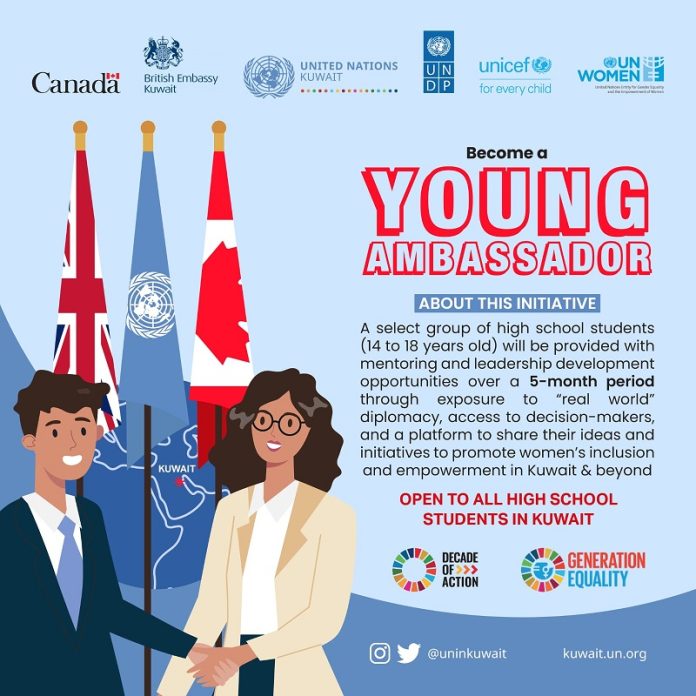On 11 October, the world commemorated the 10th anniversary of the International Day of the Girl Child (IDG). Over the past ten years, there has been increased attention on issues that matter to girls amongst governments, policymakers and the general public, and more opportunities for girls to have their voices heard on the global stage. Yet, investments in girls’ rights remain limited, and girls continue to confront a myriad of challenges to fulfilling their potential, made worse by concurrent crises of climate change, COVID-19 and humanitarian conflict.
The Embassy of Canada, in collaboration with the British Embassy, United Nations Resident Coordinator Office, in coordination with UNDP, UNICEF and UN Women in the State of Kuwait, have invited high school students to partake in the ‘Young Ambassadors’ initiative, which allows students to work with corresponding embassies. The selected students will be provided with mentoring and leadership development opportunities over a five-month period, through exposure to ‘real-world diplomacy’, access to decision-makers, and a platform to share their ideas and initiatives to promote women’s inclusion and empowerment in Kuwait and beyond.
As the Ambassador of Canada, H.E. Aliya Mawani, stated: “When everyone in society participates equally, communities are more prosperous and more secure. Everyone benefits. I’m so excited about this collaborative, intergenerational partnership to advance United Nations SDG 5 — promoting gender equality — which is also a core priority for Canada. Through this initiative, students in Kuwait will experience real-life diplomacy, develop leadership skills, and gain support and tools to be confident and effective champions for gender equality. I can’t wait to meet and learn from these Young Ambassadors!”
For his part, the United Nations Secretary General Representative and Resident Coordinator to Kuwait, Dr. Tarek Elsheikh, highlighted the United Nations girls Agenda: “Adolescent girls have the right to a safe, educated, and healthy life, not only during these critical formative years, but also as they mature into women. If effectively supported during the adolescent years, girls have the potential to change the world — both as the empowered girls of today and as tomorrow’s workers, mothers, entrepreneurs, mentors, household heads, and political leaders. An investment in realizing the power of adolescent girls upholds their rights today and promises a more equitable and prosperous future, one in which half of humanity is an equal partner in solving the problems of climate change, political conflict, economic growth, disease prevention, and global sustainability. The ‘Young Ambassadors’ initiative is timely, as it provides an opportunity for youth to drive ambition towards a sustainable future for all.”
Voicing the same sentiment, the British Ambassador H.E. Belinda Lewis, noted: “Women and girls represent half of the world’s population and therefore also half of its potential. But gender inequality persists and holds back progress in many countries. On International Day of the Girl Child, I am pleased to support the launch of the UN’s ‘Young Ambassadors’ program to promote the importance of gender equality globally, as a key element of the Sustainable Development Goals. I’m looking forward to working with Kuwaiti partners on this important initiative.”
UNICEF Representative to the Gulf Area, Eltayeb Adam, added, “At UNICEF, we are pleased to welcome and support the ‘Young Ambassadors’ initiative. Girls are powerful leaders of change around the planet. They are challenging us to act on gender equality, climate action, and more. We must spare no effort to help them build a brighter future and safer world for our societies. There is also more than symbolism to today’s launch on the 10th anniversary of International Day of the Girl. We are committed to supporting the Young Ambassadors throughout the programme and beyond.”
According to UN Women, there is established and growing evidence that women’s leadership in political decision-making processes improves them. For example, research on panchayats (local councils) in India discovered that the number of drinking water projects in areas with women-led councils was 62 percent higher than in those with men-led councils. In Norway, a direct causal relationship between the presence of women in municipal councils and childcare coverage was found. Additionally, a limited number of studies have found connections between education and leadership. These studies generally suggest that as education increases, so do successful leadership behaviors.
However, around the world, 129 million girls are out of school, including 32 million of primary school age, 30 million of lower-secondary school age, and 67 million of upper-secondary school age. In countries affected by conflict, girls are more than twice as likely to be out of school than girls living in non-affected countries. Only 49 percent of countries have achieved gender parity in primary education. At the secondary level, the gap widens: 42 percent of countries have achieved gender parity in lower secondary education, and 24 percent in upper secondary education. The reasons are many and include poverty, child marriage and gender-based violence, as well as many poor families often favoring boys when investing in education.
With adversity, however, comes resourcefulness, creativity, tenacity, and resilience. The world’s 600 million adolescent girls have shown time and time again that given the skills and the opportunities, they can be the changemakers driving progress in their communities, building back stronger for all, including women, boys and men.

















